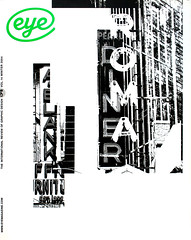Winter 2004
Brand madness 2
Letter from Rick Poynor
I enjoyed Nick Bell’s article about the branding of art galleries and agree with much of what he said.
I was surprised, though, by his comments about the Barbican Art Gallery. The article doesn’t make it clear that Nick has a stake in this – twice over – in the work he did for the ‘Communicate’ exhibition. He designed the accompanying book and also the exhibition graphics. As he must know, it is simply not true, in these projects, that ‘the visual agenda of marketing, branding and promotion [was] employed at a curatorial, editorial level’. In the case of the book, he was given a free hand by the Barbican, by the publisher and by me to come up with a design that did indeed reflect the content, and had no connection with the gallery’s new identity designed by North. At no point, here or anywhere else, did the Barbican’s marketing department make any attempt to involve itself with the editorial or curatorial process, as Nick’s statement implies.
In the case of the exhibition, Nick readily took on the exhibition graphics knowing he would have to work with the Barbican’s new identity. From my point of view, as guest curator, his graphics are a model of clarity, complement the displays well, and express the spirit and concerns of the whole enterprise. I am not a fan of Futura as a 21st-century typeface but, given how well Nick has used it, I don’t believe that a different typeface – which is what it boils down to – would have made any significant difference to the way that the exhibition functions or communicates inside the gallery. What Nick overlooks in his discussion is that the Barbican Art Gallery, which reopened in April 2004 after being refitted, badly needed a confident, contemporary, distinctive new identity for its advertising and promotional literature to remind people about its presence and help to excite potential visitors about its programme. At this point, by any rational assessment, this must be the priority. The Barbican Centre has long suffered from the perception that it is ‘awkward to get to’. Its gallery has staged many fine exhibitions, but they were easy to miss. Simply putting on more good shows, represented by a mishmash of graphic approaches, was not enough.
The dynamic larger display graphics, used for exhibition titles, work very effectively in the gallery, and it makes sense, for now, to reinforce impressions of the identity in this way. If it is not to become predictable and counter-productive, the identity will need to evolve, and a greater sensitivity to the exhibitions’ visual content will certainly be vital.
Such approaches are hardly new in any case. Richard Hollis’s work for the Whitechapel Art Gallery in the 1970s, displayed in ‘Communicate’, shows the power of a consistent but flexible typographic approach as an expression of both gallery identity and a varied curatorial programme. In the early 1990s, 8vo’s typographic posters and catalogues – to which North’s approach at the Barbican owes an obvious debt – did something similar for director Wim Crouwel at the Boymans-van Beuningen Museum, Rotterdam (see Eye no. 37 vol. 10). Surely Nick wouldn’t regard all attempts at a consistent typographic identity in the gallery context as unacceptably heavy-handed branding?
London
First published in Eye no. 54 vol. 14 2004
Eye is the world’s most beautiful and collectable graphic design journal, published quarterly for professional designers, students and anyone interested in critical, informed writing about graphic design and visual culture. It is available from all good design bookshops and online at the Eye shop, where you can buy subscriptions, back issues and single copies of the latest issue. You can also browse visual samples of recent issues at Eye before You Buy.

